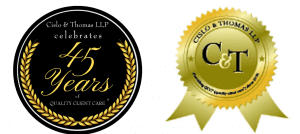Patent Frequently Asked Questions
How long does a patent last?
Patents issued after June 8, 1995 will expire 20 years from the date of the filing, but maintenance fees must be paid to keep them active. Design patents expire 14 years from the date of issue, except for a design patent issued from any applications filed on or after May 13, 2015. These design patents will expire in 15 years from the date of issuance.
What is a design patent? When is it used?
A design patent covers the ornamental aspects of a product. By definition, ornamental aspects must not be functional. For instance, if you have a chair with a colorful pattern on the seat, you could attempt to procure a design patent for the pattern, because it is decorative but does not affect the functionality of the chair as a place to sit.
I have a patent on something, and I know somebody else is selling it – what now?
What if the infringer is in a foreign country – what laws apply?
If you find that your patent is being infringed upon, we recommend that you contact a reputable intellectual property attorney immediately. The attorney will typically send out a cease and desist letter asking the infringer to stop selling the product or face legal consequences. He may also need to compare your patent to the infringing device to determine if it does in fact infringe. Even if the infringer is in a foreign country, the laws of the United States apply if the item is being sold in the United States, for instance if it is sold to U.S. customers over the Internet. U.S. sales create “minimum contacts” which allow the United States to exercise jurisdiction over the foreign infringer. If the item which infringes is only being sold in the foreign country, then the laws of that country would apply. A U.S. patent will only protect your rights with relation to the United States. Alternatively, to protect your foreign rights, you could file a Patent Cooperation Treaty (“PCT”) application, followed by a “national phase” in designated foreign countries.
I’ve heard that there are some companies claiming to own the technology behind online shopping carts. I sell things on my website. Am I in danger of being sued? Do I have to pay someone a license fee?
If you receive notice that you are infringing, it would be best if you contacted a patent attorney with the particular patent that your accuser claims to own and have it analyzed and compared with the process being used on your website to evaluate the validity of the claim against you. We do not recommend paying a licensing fee without investigating whether or not the party requesting the fee is the legal owner of the technology you are using.
My company is expanding and selling our product internationally now. Does my U.S. patent protect our rights abroad?
No. You have one year from the time you filed the U.S. utility application to file a PCT application which generally covers the countries that are members of the World Intellectual Property Organization (“WIPO”). You then have between 20-30 months, depending on the country, to decide if you want to further protect your rights in certain countries by filing individual applications in those countries. This timeline may be shorter for applications devoted to ornamental features.
My employee invented a new product while he was at work on my premises. Does it belong to him or me?
This question goes to the employment relationship. If the nature of your business involves research, development and invention, it is a good idea to have all employees sign an agreement stating that anything invented while they are working for you is your property. However, in the absence of such an agreement, the courts look at the type of employment the employee has. If the employee is an engineer, someone who was hired to invent or who would invent in the course of his work, the patent most likely belongs to the company. If the employee is an independent contractor (someone who provides his own materials for work and does not receive benefits from the company), in the absence of another agreement with respect to patents, he would likely own his invention. Other considerations the court would look at are if the employee created the invention while on the clock, if he used materials or equipment from the job to create the invention, or if he did it on his own time with his own materials. If you believe you may have an issue like this now or in the future, it is best to consult an attorney to have an agreement drafted that makes it clear that inventions devised at work are the company’s property.
How unique is unique? What can I do to help ensure the patent office will not reject my application?
The patent office requires that an invention be new and that it be nonobvious to a person skilled in the art. For instance, if you invent a new type of software, it must seem unique and innovative to a person who is an expert in computer software, not just to a lay person. An invention may be an improvement upon an existing product; however, if it is an improvement, you may have to have the permission of the owner of the patent upon which you made the improvement to actually make and/or sell your product. To avoid having your application rejected, make sure to include everything that you know about the invention and hire a good patent attorney.
What is the one-year rule with regard to foreign filing?
A PCT foreign filing can only claim up to one year priority to another patent application; so a foreign utility application must be filed within a year of the earliest priority date and that may be from a provisional or a non-provisional application. However, foreign applications directed to the ornamental (i.e., design) features of an invention must generally be filed within six (6) months of the earliest priority date.
What is a post-office patent? Does it hold up?
A post-office patent refers to the commonly held belief that you can prove your date of invention by mailing a description of the invention to yourself via certified mail and keeping the sealed envelope. In truth, the United States Patent and Trademark Office (USPTO) has ruled that this tactic has little or no legal value.
What is a claim? What is the difference between an independent claim and a dependent claim?
Patent claims establish the boundaries or scope of an invention, including the best mode to make, use or sell it. A dependent claim relies upon an independent claim and includes all the limitations of the independent claim. For instance, the independent claim might be “a device that does X” and the dependent claim “the device defined in claim 1, additionally comprising an attachment that does Y.” Therefore, the independent claims will be the broadest protection that you will have and the dependent claims are typically drafted to add further limitations and specifics to your invention.
I invented my product, but when I went to a trade show I found my competitor selling nearly the same thing. However, I’m sure I invented it first. How can I prove this?
You may be able to prove a date of invention if you have notes or records with dates about when you came up with your invention. These notes have to be corroborated, which means somebody else has to verify that they are genuine and the dates referenced correct.
What is a class? Can something be patented as more than one class?
Patents are classified in the U.S. by a system using a 3 digit class and a subclass to describe every similar grouping of patent art. A single invention may be described by multiple classification codes.
I filed for a patent and it hasn’t been issued yet, but I’ve made modifications to my invention that I’d like included. Can I make changes to an application that is in progress?
You can if examination has not yet begun, meaning you haven’t received any correspondence from the PTO, by filing a preliminary amendment. However, the date of priority will now be the date you file the preliminary amendment. If examination has begun, you can file a continuation, continuation-in-part or a new utility application to incorporate your changes or improvements.
What is the doctrine of equivalents?
It is an equitable remedy made by the courts that allows a patent holder to recover under the “spirit” of the patent. This means if a device, method or apparatus does substantially the same thing in substantially the same way, with substantially the same elements, the court may find that even though there is no literal infringement, that the spirit of the patent may infringe.
What do the terms “patent pending” and “patent applied for” mean?
They are terms used by a manufacturer or seller of an invention to inform the public that an application for a patent on that invention is on file with the PTO. The law imposes a fine on those who use these terms falsely to deceive the public.
How long does a U.S. patent application take to grant?
In 2020 the USPTO’s eight-year trend of reducing patent application pendency continued to trend downward, with the average time from filing to first action being 14.7 months. The average total pendency — that is, the time from filing to either grant or abandonment — was 23.3 months. Both of these numbers were slightly below last year’s averages. Read more about the wait times broken down by technology category HERE.



